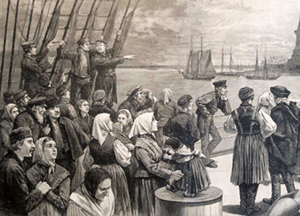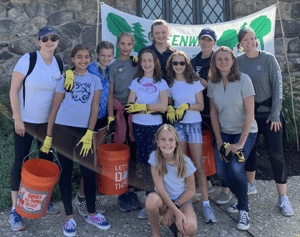Too often, the type of learning that takes place in typical Social Studies classes involves students passively taking in information about something that happened in the past and eventually repeating that information. Often, there will also be some application of the student’s understanding which they present through a debate, an essay, or the like. Most Social Studies students do not have the opportunity to see how that information connects to their lives, or to take any action that relates their understanding of the information to their world. When I used to teach such a curriculum, I was frequently asked such questions as “Why do we have to learn this?” or “What does this have to do with my life?” These were challenging to answer.
Individuals & Societies – Making the connection to the past, present and future
The Social Studies classes at Whitby School are very different. The grades 5-8 International Baccalaureate curriculum redefines Social Studies as “Individuals and Societies.” This approach seeks to explain to students why people think and act the way they do, and how this has resulted in various societies being organized the way that they are. Our students learn about big ideas that shape behavior and societies, and dive deeply into the world around them. I am never asked “What does this have to do with my life?” because we constantly deal with issues that they see in their lives.
In most of our Social Studies units, students learn about ideas and how they have impacted society. They are shown how they can actively participate in the debates provoked by these ideas. Our students are taught how to be active, not passive learners. I’ll share to two examples to illuminate this process of participatory action.
"Whitby students learn about big ideas that shape behavior and societies, and dive deeply into the world around them."
Participatory Action Example 1: Immigration
In 6th grade, our students study the concept of immigration. In most Social Studies curricula, these are what are often called “Ellis Island units.” Students hopefully come away understanding why people leave their home countries, how they decide which country to go to, and what it is like for them when they get there. This is important information, but many are left thinking that people only immigrated to the U.S. long ago.
I extend this understanding and relevancy in two distinct ways:
 Holistic Understanding. We look at immigration globally, investigating how and why people have immigrated to other countries such as Britain, Germany, Peru, Australia, and France. Students learn that immigration is a human pattern, and not just something that happened in the U.S. More importantly, students are then connected to the role of immigration in their lives. They study such issues as undocumented immigrants, the DACA program, refugees, asylum seekers, and the travel ban on people from certain countries.
Holistic Understanding. We look at immigration globally, investigating how and why people have immigrated to other countries such as Britain, Germany, Peru, Australia, and France. Students learn that immigration is a human pattern, and not just something that happened in the U.S. More importantly, students are then connected to the role of immigration in their lives. They study such issues as undocumented immigrants, the DACA program, refugees, asylum seekers, and the travel ban on people from certain countries.
Student Action: Once they have this advanced understanding, the final step is for the student take action. In this instance, students write their representatives in Congress with their ideas on what should be done about undocumented immigrants, and other related topics.
Participatory Action Example 2: Environmental Justice
Understanding and Research. The same process is followed when the students study Environmental Justice. Students learn about the history of environmentalism, the role of externalities in causing environmental harm, and how collective action can force governments or corporations to redress this damage. The students use this knowledge as they individually research an environmental issue of their choosing.
 Student Action. Students consult with an expert about their issue and then take action on it. These actions have taken shape in ways that most people find unimaginable for 12-year-olds.
Student Action. Students consult with an expert about their issue and then take action on it. These actions have taken shape in ways that most people find unimaginable for 12-year-olds.
- One student consulted with the regional manager of a supermarket chain about how they could inform consumers about the pollution that is caused by factory farmed meat.
- Another raised awareness among Whitby families about how runoff from the nitrates in fertilizers used on lawns causes pollution in Long Island Sound.
- Another student worked with our administration and our Parents Association to successfully remove the use of plastic bottles in our school.
- A group of three students started Greenwich Bottles No More with the ambitious goal of convincing the government of Greenwich to ban single use plastic water bottles.
When students see how their learning connects with their world, they are more engaged and gain a higher level of understanding. When they employ this understanding in the greater world, they come to believe that they can make a difference. This sense of empowerment and confidence is something they carry with them long after they have finished my class. This is the power of participatory action learning.
"When students see how their learning connects with their world, they are more engaged and gain a higher level of understanding.
This is the power of participatory action learning."
Participatory action seeks to explain to students why people think and act the way they do, and how this has resulted in various societies being organized the way that they are. Our students learn about big ideas that shape behavior and societies, and dive deeply into the world around them. I am never asked “What does this have to do with my life?” because we constantly deal with issues that they see in their lives.
Too often, the type of learning that takes place in typical Social Studies classes involves students passively taking in information about something that happened in the past and eventually repeating that information. Most Social Studies students do not have the opportunity to see how that information connects to their lives, or to take any action that relates their understanding of the information to their world.
International Baccalaureate redefines the traditional way of approaching social studies with the “Individuals & Societies” approach that seeks to explain to students why people think and act the way they do, and how this has resulted in various societies being organized the way that they are. Students learn about big ideas that shape behavior and societies, and dive deeply into the world around them with participatory action.
Individuals & Societies – Making the connection to the past, present and future
The Social Studies classes at Whitby School are very different. The grades 5-8 International Baccalaureate curriculum redefines Social Studies as “Individuals and Societies.” This approach seeks to explain to students why people think and act the way they do, and how this has resulted in various societies being organized the way that they are. Our students learn about big ideas that shape behavior and societies, and dive deeply into the world around them. I am never asked “What does this have to do with my life?” because we constantly deal with issues that they see in their lives.
